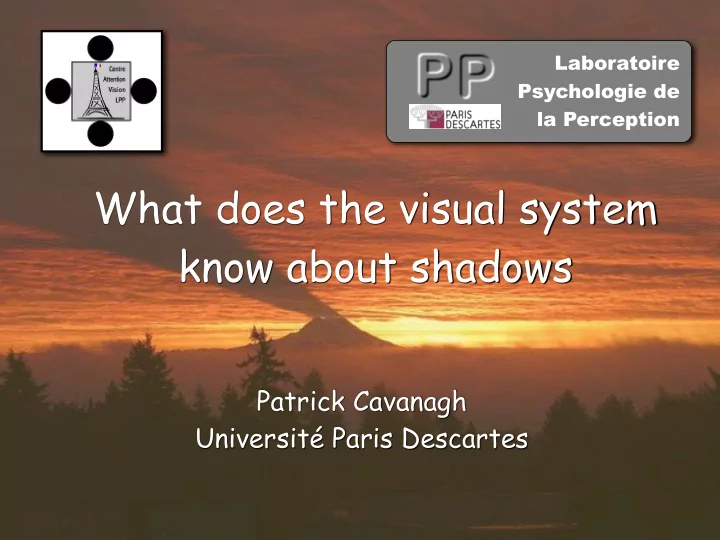

Laboratoire Psychologie de la Perception What does the visual system know about shadows Patrick Cavanagh Université Paris Descartes
Processing shadows 1. Recognize shadows 2. Use their information for relative position and surface shape 3. Throw them out
Shadow terms !
1. Recognizing shadows Some simple rules Help from conjoint shape-shadow recovery
Simple rules for what is a shadow Cavanagh & Leclerc 1989 No. 277, Jiro Takamatsu, 1968 Shadow-object inconsistency Can’t always OK as long as shadow is darker check the shape
Inconsistency goes unnoticed Fra Carnevale, Birth of the Virgin, 1467
When is an inconsistency noticed? Pawan Sinha altering newpaper photo of photographer Cornell Capa Shadows must be consistent within object
How quickly do we find a BAD illuminant? Ostrovsky, Cavanagh, Sinha, 2005 About 5000 ms
Simple rules for what is a shadow Cavanagh & Leclerc 1989 A shadow should not have its own contour or texture Cavanagh & Kennedy, Science 2000
Simple rules for what is a shadow Cavanagh & Leclerc 1989 Maurice de Vlaminck, Still Life Georges Braque Can be wrong color But not darker, not good
Simple rules for what is a shadow Cavanagh & Leclerc 1989 Can be wrong color but must be darker
Simple rules for what is a shadow Cavanagh & Leclerc 1989 Shadows should not have volume — must appear to lie flat on surface
Recognizing object and shadow together 2-tone images: cannot tell black shadow from black pigment Unless you already know what the object is Tolstoy, Giorgio Kienerk, 1904 But cannot identify object until you identify shadow vs pigment
How? Two-tone image Contours Cavanagh, 1991 Ignore cast shadow contours 2D match finds some Retrieve prototypical characteristic head from memory, contours of a face check against image
The contours alone are often impossible to recognize
The recognition requires a familiar object Here same, parts, different arrangements
Recognize a shadow Simple shadow rules: darker, no border, no volume Can be checked LOCALLY Do not need to check if shadows consistent across the whole scene. Sometimes shadows come as part of object recognition
2. Recover information Relative position Object shape Surface shape
Relative position Pascal Mamassian
Relative position !
Relative position
Relative position Offset or absent cast shadow can make you float
Object shape Shadows are silhouettes of the casting object Seen from the light’s viewpoint Silhouettes are sometimes interpretable
Object shape But often not And a different viewpoint is not readily integrated into object information !
Surface structure Often too complicated !
3. Throw them out Shadow contours are noise when it comes to identifying object shapes At some point they need to be removed Image All contours “Depth sketch”
When are they thrown out? Visual search for an odd tilt Much slower if the tilted element Rensink & Cavanagh, appears to be a shadow 2004 Than if not Slow Faster
Search was fast Target Distractor Search was slow Target Distractor Darker, no contour Taken as shadow and removed before search can access them
How quickly do we determine what is a shadow? Faster than the beginning of rapid visual search About 150 msec
3. Throw them out Where are they thrown out? Areas of visual system that no longer represent shadow borders.
Processing shadows 1. Recognize shadows 2. Use their information for relative position and surface shape 3. Throw them out
Recommend
More recommend